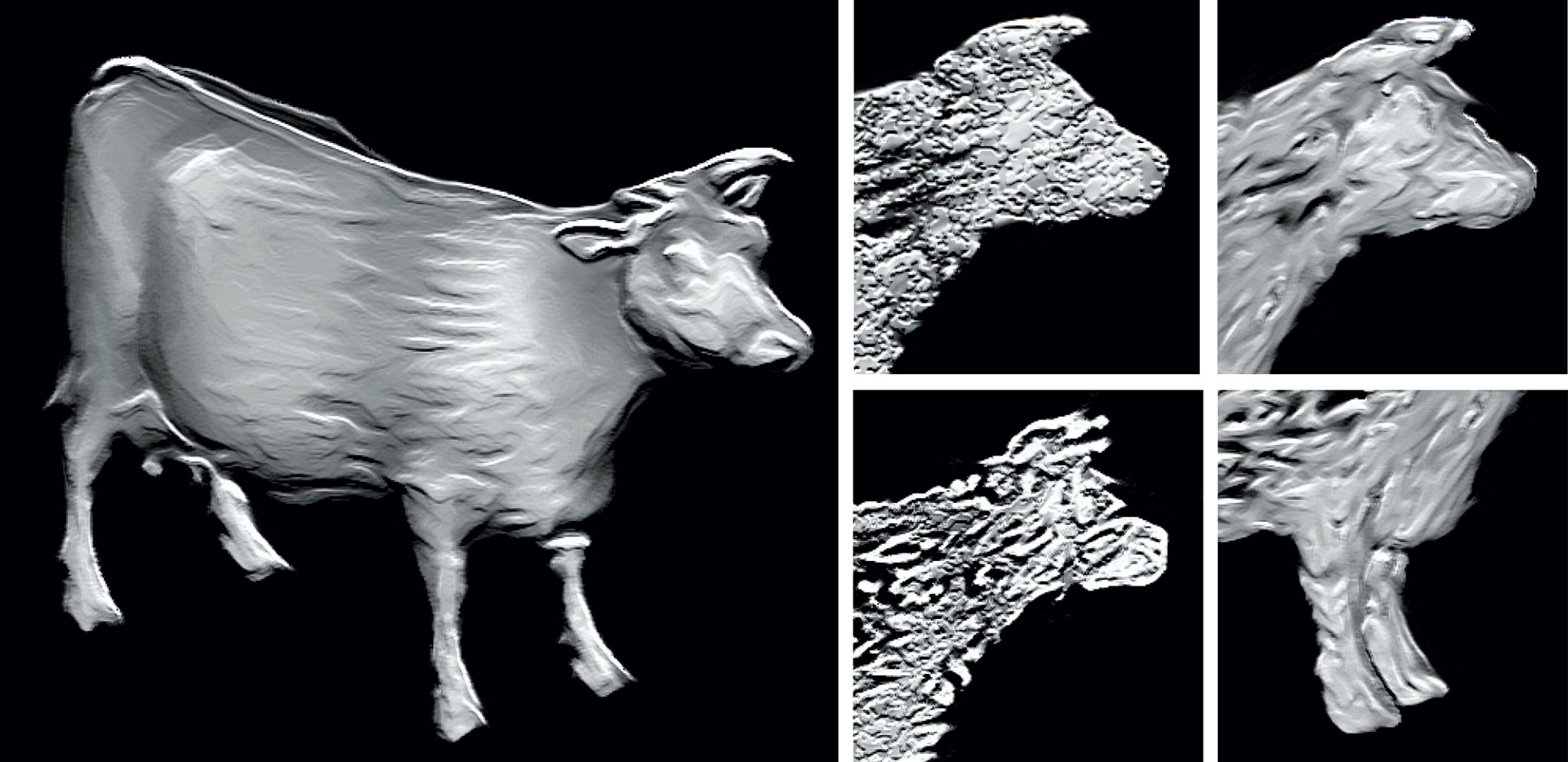“Kizamu: a system for sculpting digital characters” by Perry and Frisken
Conference:
Type(s):
Title:
- Kizamu: a system for sculpting digital characters
Presenter(s)/Author(s):
Abstract:
This paper presents Kizamu, a computer-based sculpting system for creating digital characters for the entertainment industry. Kizamu incorporates a blend of new algorithms, significant technical advances, and novel user interaction paradigms into a system that is both powerful and unique.
To meet the demands of high-end digital character design, Kizamu addresses three requirements posed to us by a major production studio. First, animators and artists want digital clay — a medium with the characteristics of real clay and the advantages of being digital. Second, the system should run on standard hardware at interactive rates. Finally, the system must accept and generate standard 3D representations thereby enabling integration into an existing animation production pipeline.
At the heart of the Kizamu system are Adaptively Sampled Distance Fields (ADFs), a volumetric shape representation with the characteristics required for digital clay. In this paper, we describe the system and present the major research advances in ADFs that were required to make Kizamu a reality.
References:
1. R. Avila and L. Sobierajski, “A haptic interaction method for volume visualization”, Proc. IEEE Visualization’96, pp. 197-204, 1996.
2. J. Baerentzen, “Octree-based volume sculpting”, Proc. Late Breaking Hot Topics, IEEE Visualization’98, pp. 9-12, 1998.
3. J. Bloomenthal, “Polygonization of Implicit Surfaces”, Computer Aided Geometric Design, 5(00): pp.341-355, 1988.
4. M. R. Bolin and G. W. Meyer, “A perceptually based adaptive sampling algorithm”, Proc. SIGGRAPH’98, pp. 299-310, 1998.
5. D. Breen, S. Mauch and R. Whitaker, “3D scan conversion of CSG models into distance volumes”, Proc. 1998 IEEE Symp. on Volume Visualization, pp. 7-14, 1998.
6. P. Cignoni, F. Ganovelli, C. Montani, and R. Scopigno, “Reconstruction of Topologically Correct and Adaptive Trilinear Isosurfaces”, Computers & Graphics, Elsevier Science, Vol. 24, no. 3, pp. 399-418, 2000.
7. O. Cuisenaire, “Distance Transformations: Fast Algorithms and Applications to Medical Image Processing”, Ph.D. thesis, Universite Catholique de Louvain, 1999.
8. B. Curless and M. Levoy., “A Volumetric Method for Building Complex Models from Range Images”, Proc. SIGGRAPH `96, pp. 303-312, 1996.
9. T. DeRose, M. Kass, T. Truong, “Subdivision surfaces in character animation”, Proc. SIGGRAPH ’98, pp. 85-94, 1998.
10. D. Ebert, F. Musgrave, D. Peachy, K. Perlin, and S. Worley, Texturing and Modeling a Procedural Approach, Academic Press, 1998.
11. B. Fowler, “Geometric manipulation of tensor product surfaces”, Proc. of the 1992 Symposium on Interactive 3D Graphics, pp. 101-108, 1992.
12. S. Frisken, R. Perry, A. Rockwood, and T. Jones, “Adaptively Sampled Distance Fields: A General Representation of Shape for Computer Graphics”, Proc. SIG-GRAPH ’00, pp. 249-254, 2000.
13. T. Galyean and J. Hughes, “Sculpting: An Interactive Volumetric Modeling Technique”, Proc. SIGGRAPH ’91, pp. 267-274, 1991.
14. S. Gibson, “Using distance maps for smooth surface representation in sampled volumes”, Proc. 1998 IEEE Volume Visualization Symposium, pp. 23-30, 1998.
15. B. Guo, “Progressive Radiance Evaluation Using Directional Coherence Maps”, Proc. SIGGRAPH ’98, pp. 255-266, 1998.
16. D. Karron and J. Cox, “New findings from the SpiderWeb algorithm: toward a digital morse theory”, Proc. Vis. in Biomedical Computing , pp.643-657, 1994.
17. A. Khodakovsky and P. Schroder, “Fine Level Feature Editing for Subdivision Surfaces”, in ACM Solid Modeling Symposium, 1999.
18. J. Letteri, Visual Effects Supervisor, Industrial Light and Magic, personal communication.
19. W. Lorensen and H. Cline, “Marching Cubes: A High Resolution 3D Surface Construction Algorithm”, Proc. SIGGRAPH ’87, pp.163-169, 1987.
20. D. Mitchell, “Generating antialiased images at low sampling densities”, Proc. SIGGRAPH ’87, pp. 65-72, 1987.
21. T. Nishita, T.W. Sederberg and M. Kakimoto, “Ray tracing trimmed rational surface patches”, Proc. SIGGRAPH ’90, pp. 337-345, 1990.
22. S. Rusinkiewicz and M. Levoy, “Qsplat: A Multiresolution Point Rendering System for Large Meshes”, Proc. SIGGRAPH’00, pp. 343-352, 2000.
23. R. Shekhar, E. Fayyad, R. Yagel, and J. Cornhill, “Octree-based decimation of Marching Cubes Surfaces”, in Visualization’96, pp. 335-342, 1996.
24. D. Terzopoulos, and H. Qin, “Dynamic NURBS with geometric constraints for interactive sculpting”, ACM Transactions On Graphics, 13(2), pp. 103-136, 1994.
25. S. Wang and A. Kaufman, ” Volume sculpting”, 1995 Symposium on Interactive 3D Graphics, ACM SIGGRAPH, pp. 151-156, 1995.
26. R. Westermann, L. Kobbelt, and T. Ertl, “Real-time exploration of regular volume data by adaptive reconstruction of isosurfaces”, The Visual Computer, 15, pp. 100-111, 1999.
27. M. Wheeler, “Automatic Modeling and Localization for Object Recognition”, Ph.D. thesis, Carnegie Mellon University, 1996.
28. B. Wyvill, C. McPheeters, and G. Wyvill, “Animating soft objects” The Visual Computer, 2(4):235-242, 1986.





